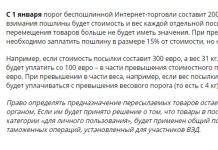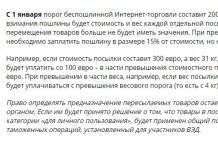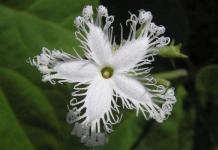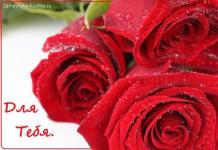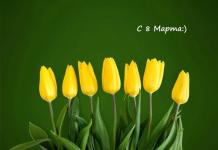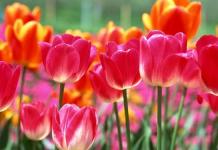Narcissists have been accompanying mankind, as they say, both in trouble and in joy for more than two millennia. Some peoples decorated the deathbed with delicate flowers, while others used narcissus as a way of declaring love, a symbol of the triumph of life and light.
It is believed that Hippocrates gave a name to a poisonous plant with an intoxicating aroma. Much later, scientists, having studied the chemical composition of the flower, confirmed that the words “narcissus” and “narcosis”, “drug” are of the same root.
Myths and legends are associated with the flower, but today we are interested in it as a decorative culture. All the nuances of growing and using daffodils in landscape design are collected in this article.
The flower, which for several centuries was given an almost mystical meaning, could not but excite the imagination of breeders of different eras.
As a result, modern designers have several dozen varieties, the difference of which is in the form (the ratio of the length of the crown and perianth, the number of flowers) and color.
The flowering period of most daffodils in the Moscow region, the Middle lane is April-May, in the Urals and Siberia - the end of May-June.
The crown, or as it is also called, the tube, comes in different shapes: in the form of a bell, a bowl, a saucer.
The terry shape of the crown can not always be distinguished: it is lost, forms one whole with the terry perianth petals. The latter has 6 petals in a classic inflorescence.
Main types:
Tubular (trumpet) daffodils
They make up about a third of all representatives of these flowers. The ratio of the length of the elements of the inflorescence is approximately equal, 1 flower rises on a bare peduncle.

It reproduces well, forming dense green islands, abundantly strewn with flowers.
- Golden Harvest - thick, rich yellow tone of large, about 7-8 cm, inflorescences with a corrugated crown; height 40-50cm.
- Dutch Master - bloom for at least 2 weeks with large, 8-9 cm, yellow flowers, tube with needle tips; height 40-50 cm.
- Mount Hood - flowering period - up to one and a half weeks; very large (10-12 cm or more) inflorescences of delicate light shades: milky white, creamy cream, ivory. Hue saturation is determined by weather conditions: higher temperature - thicker tone. Height - up to 40 cm.
- PinkParasol - the core of a delicate salmon shade, perianth - a soft creamy tone, diameter up to 8-9 cm, height up to 40 cm.
- Regeneration - the whole flower is painted with a delicate lemon color, and only at the base of the perianth petals is an almost white rim. Not less than 8 cm in diameter, height up to 55 cm
Large-crowned (large cupped)
The showiness, brightness, variety of colors of this type of daffodils explain why it is the large-crowned varieties that make up almost half of the entire diversity of the culture.

- Professor Einstein - large, up to 15 cm, inflorescences in a bright palette: a flat wide core of a dense orange tone against a background of pearly white soft rounded petals. Height up to 50 cm. Unpretentious, winter-hardy.
- Pink Charm - a corrugated crown, from thick red turns pale towards the center to a delicate apricot, and the perianth is snow-white. The peduncle up to 50 cm is crowned with two buds, each of which opens up to 10 cm in diameter.
- British Gamble - a high crown from soft pink in the center, pours in a thick color to the ruffled edges. Saturation gives a snow-white background of the perianth. On short, about 30 cm, peduncles, flowers no less than 12-14 cm in size look simply huge.
- Donau Park, Slim Whitman, Lemon Beauty, Salome, Spring Pride, Avalon - all sorts of combinations of all shades of classic colors - white and yellow.
Small-cupped (small cupped)
The name of the species denotes the peculiarity of the flower - the crown of these daffodils is no more than the length of the perianth petals.

A later flowering period allows you to extend the overall sound of daffodils in the flower garden: when the representatives of the previous species fade, the time comes for the small-crowned ones.
- Audubon is a white perianth with outstretched petals and a slightly noticeable green at the base, a crown from almost white in the center is poured to the edges with a thick red color. Diameter - up to 10 cm, height about 40 cm.
- Barret Brownung - dense orange, almost red to the edges, heartwood against a background of white perianths. Dimensions - 8-9 cm diameter, 40 cm height.
- Rockall - the color scheme is the same, but the plant is larger: the flower is up to 11 cm, the height of the peduncle is up to 45 cm.
Triandrus (triandrus)
Several drooping inflorescences with slightly recurved perianth petals - salient feature kind.

The shape gives a special touching and tenderness to the flower garden, decorated with multi-flowered daffodils.
- Thalia is a white flower with a subtle lemon tinge, more than 10-12 cm in diameter, Hawera is undersized (up to 20 cm) with monochromatic yellow flowers about 3 cm.
- Tresamble - 3 buds on each peduncle: lemon core, white petals, up to 8 cm, height - 30 cm.
Terry (double)
The most popular group of daffodils with all possible variations of shapes and shades: one-color and two-color, with one flower or several buds, with a double perianth and a simple crown and vice versa, with both parts of the flower of a double shape.

- Sir Winston Churchill (multi-flowered), Replete, Delnashaugh - intertwined milky white or creamy perianth petals and terry from pale apricot to deep red heart form a single whole - a surprisingly delicate combination.
- Tahiti, Innovator - terry weaves of creamy honey petals and an orange core.
- Flyer - the pompom of this narcissus resembles a large carnation or a small yellow peony - the terry petals and crown are so dissected. 6-8 cm flower, up to 50 cm - peduncle.
- Full House - simple in shape, the perianth is stuffed with a highly corrugated crown, resembling a dense pompom. 10 cm diameter, up to 45 cm height.
- Rosy Cloud is a pale pink color of a simple perianth and a dense double heartwood. Flower size 7-8 cm, peduncle - up to 50 cm.
Cyclamenoid (cyclamineus)
 High, brightly distinguished tube, petals bent back, low, up to 30 cm, peduncle, long flowering.
High, brightly distinguished tube, petals bent back, low, up to 30 cm, peduncle, long flowering.
The yellow varieties Baby Dole and Jetfire differ in the color of the crown: in the first it is the same tone with the petals, in the second it is two tones darker, light orange.
Flowers are up to 8 cm.
Jumblie is miniature, not higher than 10 cm, the shade of the tube is slightly darker than the petals, the diameter of which is about 4 cm.
Jonquilla (jonquilla)
Many-flowered and very fragrant, up to 7 cm inflorescence of a classical form and a peduncle up to 30 cm high.

- Step Forward - delicate lemon petals and a slightly noticeable yellowness of the tube.
- Hillstar - bright yellow petals at the base are white. From this light center, a cupped white core emerges.
- Suzy - a thick red crown turns pale closer to the base, and the petals are a soft yellow hue.
Split-crown (split corona)
The split segments of the highly corrugated crown either adjoin the petals, or, conversely, lag behind it, forming unique shapes from variety to variety.

The combination of colors is the most diverse.
- Cum Laude - the Latin name goes back to the presentation of the award, which is justified by the appearance of the narcissus: light cream at the base and bright peach to the ends, the dissected lobes of the crown gently rest on the white perianth. Flowering up to 3 weeks, flower - from 10 cm, height - 40.
- Taurus - in shape it resembles the previous variety, but in the color of the dissected terry crown there is more yellowness, thicker shades, and a height of up to 50 cm.
- Vanilla Peach - against the background of white petals, a heavily dissected crown of tender Pink colour forms a soft terry pompom. A very gentle combination of tones, soft lines - a refined appearance. The size of the inflorescences is 7-9 cm, the height of the plant is 35 cm.
- Pink Wonder - it is not for nothing that the flower is called a “miracle”, and the definition of “pink” does not limit the color possibilities of the variety. Large, 10 cm, the flower blooms yellow, then repaints in soft peach, and finishes flowering with pink pastel. This palette plays against the background of very light petals with a hint of ivory for 3 weeks.
- Orangery - first snow-white, and then - pale cream petals and changing each other orange and apricot tones pour over time, become thicker, deeper. Flowering up to a month. Peduncle high - up to 50 cm.
Other popular varieties of daffodils
 Poetic (poeticus) - large (up to 9 cm) perianths are white, and a flat dark yellow crown along the very edge is crimson red.
Poetic (poeticus) - large (up to 9 cm) perianths are white, and a flat dark yellow crown along the very edge is crimson red.  Multi-flowered or tacetate (tazetta bunch flowered) - another "bouquet" form: 3-5 buds on the peduncle. The shape of the flowers is simple, the tube is short.
Multi-flowered or tacetate (tazetta bunch flowered) - another "bouquet" form: 3-5 buds on the peduncle. The shape of the flowers is simple, the tube is short. There are few varieties, but all with a strong aroma. These daffodils require mandatory shelter for the winter.
The brightest representatives of the species are Geranium (white petals, bright orange crown), Minnow (up to 8 buds, pale lemon perianth, bright yellow crown cup). An atypical representative of the species is Erlicheer.
Each plant of this variety is already a bouquet: up to 20 small double white inflorescences with yellow cores.
 Wild daffodils (Wild Species), a separate large group, many of whose representatives have become an experimental base for breeders, gave names to popular species.
Wild daffodils (Wild Species), a separate large group, many of whose representatives have become an experimental base for breeders, gave names to popular species. Separately, in this group, an unusual bulbocodium (bulbocodium) is distinguished - a bright yellow funnel of a flower expanding from the base to the edges resembles a mouthpiece.
 Cantabrian (cantabricus) is almost identical to the previous one, but its snow-white fluttering “bells” evoke a very touching feeling of insecurity. And you need to protect both of these plants - in Russia, without shelter, they will freeze in the winter.
Cantabrian (cantabricus) is almost identical to the previous one, but its snow-white fluttering “bells” evoke a very touching feeling of insecurity. And you need to protect both of these plants - in Russia, without shelter, they will freeze in the winter. Species (all species) and other (others, miscellaneous), hybrids, varieties are drawn up according to clear criteria.
It is required to indicate:
- grade;
- originator;
- in which year it was registered;
- country of registration;
- alphanumeric code: group number, letter - color of perianth petals, letter - crown color.
Additional information in the classification is the multiplication factor from low (less than 1.5) to high (more than 2.0).
Daffodils are classified as early flowering crops. Like many bulbs, they bloom before most blooming summer ornamentals. But even in this short period, the timing of flowering is distinguished.
Early daffodils begin to bloom in April, and the latest - in mid-May. Such periodicity is typical for the Middle Strip, the Volga region.
Beyond the Urals, the first daffodils bloom in mid-May, and the later ones bloom in June.
Daffodils in landscape design
An amazingly versatile culture is the daffodil. Especially if you consider the short duration of flowering. They look great in flowerpots, containers, and they have the widest application.
 Solo groups of luxurious terry or splits, tubular or large-crowned will be a worthy decoration of the lawn, the outskirts of the lawn.
Solo groups of luxurious terry or splits, tubular or large-crowned will be a worthy decoration of the lawn, the outskirts of the lawn.
Bye fruit trees not covered with a dense crown, light-loving daffodils will fade, filling the space between the bushes and trunks of large specimens.
Planting daffodils in rows with a density of 18-20 pcs. for every meter, they receive luxurious discounts, accentuate garden paths leading deep into the garden.
 Moreover, monochromatic plantings and the alternation of 2-3 types of daffodils with each other or a combination with crops of contrasting color are equally effective.
Moreover, monochromatic plantings and the alternation of 2-3 types of daffodils with each other or a combination with crops of contrasting color are equally effective.
The combination of a dense yellow or white canvas of daffodils framed by a thick blue of muscars is breathtaking.
Daffodils are the first, along with other bulbous ones, to decorate mixborders, undersized ones are organic in rock gardens.
Borders with tall daffodils in the center and Pushkinia, tulips, Scylla, Alba Chionodoxa along the extreme line create a bright festive mood in the spring, when the main ornamental crops are just growing green and getting ready to bloom.
CherryLink plugin not foundWith the onset of the first spring warmth, primroses bloom in the flower beds. Among them, daffodils attract attention with their elegance, bright color and rich aroma. Although their flowering is short, they enjoy well-deserved love and popularity among flower growers.




Variety of shades
The flower is a member of the Amaryllis family from the genus of monocotyledonous bulbous plants. The narcissus bush has many ribbon-shaped leaves, the width of which may vary slightly in different species. A long, leafless stem (pedicel) may carry one or more inflorescences at its apex.
In addition to wild species, there are many cultivated, bred varieties. First of all, daffodils differ in the color of their inflorescences.
white daffodils
The birthplace of this plant is the Iberian Peninsula, where the flower grows on mountain slopes. Cultural cultivation of this species began at the end of the 16th century. The white daffodil has completely pure white flowers, including the inner crown. The height of the bush can reach 35 cm, and the length of the pedicel is about 25 cm. The plant has thin, numerous leaves of rich green color. The plant propagates, like all daffodils, with spherical bulbs that are small in size (about 4 cm).
Active growth occurs in mid-spring, and flowering occurs at the end of May and does not last long - only 10 days.


yellow daffodil
False narcissus is another name for it. IN wild nature grows in European countries - France, Germany and southern Italy. The culture is quite old: it has been grown in garden floriculture since the beginning of the 16th century. This species is distinguished by its small size - the maximum height is 30 cm. The pedicel has only one inflorescence, the size of which is about 4 cm. The flowers rise about 10 cm above thin dark green leaves. A fully opened inflorescence has a bright yellow corolla (crown ) with uneven wavy edges. Yellow daffodil begins to bloom from mid-May, flowering duration is about 2 weeks. Bulbs of small size (up to 4 cm) have a round shape in the form of a ball.


pink daffodils
This species is widespread in the western regions of Italy, from where it was brought to France in the 16th century. The plant is tall, can grow up to 45 cm or more, which is its characteristic difference from other species. The rich green leaves are also somewhat wider (about half a centimeter) than other daffodils. The color of the inflorescence has a feature uncharacteristic for daffodils: the crown is painted in a delicate pink color and is framed by snow-white perianth petals.
The pedicel carries only one bud, which blooms in early May. The size of the bulbs is quite large - about 5 cm.



Group overview
The inflorescence of the daffodil has the form of a tubular funnel (bell), whole or consisting of separate fragments, the base of which is bordered by a perianth in the form of spread petals. Depending on the shape of the flower and its color, plant species are divided into such groups (classes).
Tubular. This group is characterized by the presence of only one bud per stem, the length of which can be from 15 to 45 cm. The crown, which looks like a long tube, corresponds to or slightly exceeds the length of the perianth. Inflorescences can be monochromatic in white, yellow, or have a two-color color: the corolla and perianth are colored differently. Daffodils of this group are characterized by early flowering.

Large crowned. A characteristic feature of this group is that the length of the crown is 3 times less than the size of the perianth petals. The crown may be wavy or smooth. These daffodils are distinguished by a two-tone color of inflorescences, which has a wide variety of color combinations: the lower perianth petals are white, cream, yellow, and the crown is white or cream, yellow, orange or pink with a brighter border along the edge, which can be corrugated and slightly bent.

- Small crowned. The name of this group reflects a characteristic feature of plants: the size of the corolla is small and does not even reach a third of the length of the perianth. The peduncle has a single bud. The color of the lower petals is white, yellow, cream. The color of the crown is most often peach, yellow or orange, pink, and even with a red tint. Often a border of a more saturated tone runs along the edge. Flowering later, but bloom profusely.

- Terry. These daffodils are completely different from the classic plant species. The stem can carry not one, but several buds. Terry can be a perianth, and a crown, and even a combination of these two options. Flowers are monochromatic (white, yellow) and bicolor (white with a reddish crown). The pedicel often does not withstand terry hats, especially heavy after rain, and breaks off. This is considered a disadvantage of this species.

Triandrus. Plants are distinguished by a low peduncle (about 25 cm), bearing 2 or more inflorescences, which are omitted. The lower petals at the base of the crown are slightly bent back. Flowers are painted most often in white, yellow, golden tone.

- Cyclamenoid. The name itself speaks of its unusual appearance for a narcissus - on a short (15-25 cm) pedicel there is one inflorescence, with a long and narrow crown, lowered down. The perianth petals at its base are strongly bent back. They can have either one or two colors. The main shades are white, yellow, orange.

- Jonquilliae. The relatively short pedicel has 2 to 6 small flowers. These daffodils are distinguished by the rounded shape of the lower petals, which are slightly bent back. The crown also has a somewhat peculiar appearance - a small and short, but wide bowl. Inflorescences are usually yellow or white.

Tacetoid. In daffodils of this species, a peduncle 15 to 45 cm long has several buds (from 2 to 8). The outstretched petals with a wavy surface have a rounded shape, while the short crown has the shape of a glass. The leaves of the bush are wide dark green. The flowers themselves are painted in white, cream, yellow tones.


Poetic. This group is widespread on the Mediterranean coast. Plants are tall, reaching 50 cm. One bush can have up to 5 long leaves of a bright green hue. The pedicel is higher than the leaves. One blooms on the peduncle White flower with an internal rim in the form of a disk, yellow in color. Its middle can be a greenish tone, turning into a bright yellow tint with a reddish rim along the edge. The heads of the inflorescence are directed downwards. The size of the flower in the full opening phase is about 6 cm. It blooms in May for 12 days.

- Cut-crown. The peculiarity of this group of daffodils is that the crown is not solid, but is divided into separate fragments with a fringed edge. There is only 1 inflorescence on the pedicel. There are two subspecies: split-corona (coronary lobes are located above the perianth petals and adjacent to them), papillon (the shape of the flower looks like a butterfly). The tube can be of very different colors - white, red and pink, yellow and orange.


Hybrid (N. Bulbocodium). Plants of this class have a low stem (up to 15 cm in total) with one inflorescence. The narrow tepals are underdeveloped and very small in size. The crown in the inflorescence, on the contrary, is large, wide open and has a peculiar shape of a crinoline skirt.


Of course, there are other, less common species that are not included in the groups listed above. Besides, there are wild types of daffodils and their hybrids obtained naturally in natural conditions. In our country, such flowers are grown extremely rarely because they do not tolerate harsh climatic conditions.
Description of popular varieties
In nature, there are about 60 species of daffodils. Breeding work with this flower has been going on since the 18th century, and as a result, a huge number of varieties have appeared, which number several thousand. There are also a lot of the most popular and beautiful varieties, among them are such.
"Cool Flame". This variety belongs to the group of large-crowned daffodils. The inflorescence is two-colored: the crown, painted in a rich orange hue, sometimes turning into coral, stands out brightly against the background of snow-white lower petals. The crown has a characteristic strongly wavy edge. The height of the bush reaches 40-45 cm, the size of the flower is 10 cm.
Flowering occurs in April or May. The plant is unpretentious and grows well in both sunny and shady places.

Variety Rip van Winkle- a representative of the terry group. The bushes of the plant are low, growing on average up to 30 cm, and the wide leaves are somewhat lower than the flower on the peduncle. Both the lower petals and the tube are terry. Strong doubleness is created due to the large number of petals with different directions of growth. Only one flower blooms on the pedicel, which is painted in a thick yellow tint. In open ground it is grown both in lighted areas and in the shade.

- Narcissus "Bridal Crown". Each perianth petal of this variety is elliptical in shape and has a snow-white or cream color. There can be up to 4 buds on the stem, which, after full disclosure, turn into dense double flowers with soft creamy lower petals and a yellow crown in the center. The edge of the tube is corrugated. Plant height - from 30 to 45 cm, medium-sized inflorescences - up to 4 cm in diameter. Flowering occurs in mid-May.

- "Dick Wilden"- a large-flowered terry variety, a feature of which is very early flowering - already in March. The height of the bush is about 50 cm, and the inflorescences reach a size of 15 cm. The wide (up to 8 cm) lower petals are oval in shape and are colored yellow with a greenish tint. In the center of the inflorescence is a densely double lush corolla of a dark yellow tone.

- Variety "Rosie Cloud"- pink daffodil of the terry group. Even among other terry, it stands out for its beauty and atypicality. The lower petals are rose-pearl and frame a luxurious crown. The terry crown of delicate pink color is formed by densely seated petals, which amaze with their lightness and airiness, justifying their name - "Pink Clouds". The size of the inflorescence is 5-7 cm, and its color can change its saturation in accordance with the weather. Blooms profusely for 7-10 days.

- Artik Bells. The variety belongs to the hybrid group Bulbocodium. Distinguished by early and abundant flowering. The height of the bush is up to 20 cm. The stem, 25 cm high, bears only one flower, which rises above the leaves. Narrow and small greenish perianth petals are bent back. The large rim has a conical (in the form of a crinoline) shape and is much larger than the lower petals. The color of the crown is white or ivory.
The leaves of the bush are very thin, almost filiform, rich green. One bulb can produce several pedicels with buds. Blooms in April and May.

- Albus plenus odoratus. This variety of daffodils is the latest: its flowering occurs in the last decade of May - early June. In its appearance, it bears little resemblance to the classic daffodil: its light corrugated petals grow in several rows, and there is no clearly defined crown. But even the small and neat middle stands out with its bright yellow color.

- "Calgary"- This is a variety of white terry daffodils. Terry balls of inflorescences are very similar to small peonies. The peduncle grows up to 40 cm and carries 2 buds. A flower about 10 cm in size has many petals of bright white color with a barely noticeable greenish tint. The yellow stamens, located in the very center of the lush ball, seem to glow with a golden light. The bush has narrow lanceolate leaves of green color with a bluish tint.
Flowering occurs in May for 10 days. It is not capricious in cultivation, but prefers open lighted areas.

- "Delnasho"- terry two-color variety. The plant has unusually beautiful flowers with delicate airy petals. There is only 1 inflorescence on the peduncle, but it is quite large (up to 15 cm) with large snow-white rounded petals that border the lush pink-peach center. Petals (white perianth and creamy-pink multi-tiered crown), alternating, gently shade each other. Blooms in May for a long time, almost 2 weeks. Saturated color persists until the end of flowering.

- Variety Sunny Girlfriend- among relatively new varieties, it is already quite popular. Narcissus belongs to the cut-crown group. It differs from other varieties of this class in that its corolla is cut to the very base. A well-opened crown with a yellow center is painted in delicate pink-orange tones. Openwork-wavy edges have a more saturated color. The lower white petals are somewhat longer than the crown. The daffodil "Electrus" belongs to the same group. Its coral-coloured crown is fully open down to the white perianth, and each fragment of the corolla rests on the lower petals.
Crackington (Crackington)
Ice King (Ice King)
Mount Hood (Mount Hood)
Precocious (Precocus)
Rosy Cloud (Rosie Cloud)
Spellbinder (Spelbinder)
Taurus (Taurus)
Thalia (Waist)
poetic daffodil


yellow daffodil

white daffodil

pink daffodil

Narcissus Tete-a-Tete

Terry daffodils

Gay Challenger

Variety Texas

Narcissus Ice King

What does a Tahiti daffodil look like?

Narcissus Replit

Narcissus Rip Vann Winkle

Narcissus Obdam

Most often in flower beds you can find classic tubular daffodils, which are the most popular inhabitants of spring flower beds. But besides them, there are many other diverse varieties.
We have made a selection of the most beautiful varieties of daffodils, whose amazing flowers will decorate any backyard.
Crackington (Crackington)
Variety of terry daffodils with very bright and catchy flowers. Crackington daffodils are distinguished by rich yellow flowers with an equally catchy orange center. Of all the varieties of the terry group, this variety is considered one of the earliest (blooms in April). Flowers with strong peduncles, which allows you to grow them in any corner of the garden. The plant makes an excellent cut.
Ice King (Ice King)
A variety of terry variety of daffodils with amazing flowering. The flowers are luxurious and large (can reach a diameter of 13 cm) creamy white and bright yellow. By the end of spring they become creamy. The buds are distinguished by a corrugated crown. The first flowers appear already at the end of April and last for 2-3 weeks. The Ice King variety is suitable for creating exquisite spring flower beds and borders, as well as decorating borders.
Mount Hood (Mount Hood)
This variety of tubular daffodils blooms in April-May. The flowers are snow-white, very large - up to 13 cm, kept on strong peduncles. The color of a single bud can vary from creamy white to ivory. The color intensity of daffodils depends on weather conditions: the warmer the spring, the richer the color will be.
The variety is especially valued for its delicate color and light aroma. Mount Hood daffodils bloom early and are suitable for planting anywhere in the garden: in a flower bed, on an alpine hill, in a border, on a discount, between shrubs. Suitable for cutting.
Pink Champagne (Pink Champagne)
The variety belongs to the group of double daffodils with crowned flowers. In one flower, you can observe a mixture of white and bright pink shades. The multi-colored petals are randomly arranged, which gives Pink Champagne a special elegance. These daffodils bloom in early May, suitable for growing in a flower garden or along a path.
Precocious (Precocus)
A tall variety of large-crowned daffodils, characterized by a massive bud with a large perianth. A distinctive feature of these daffodils is an openwork pinkish crown. The edges of its darker shade are very strongly corrugated. The plant blooms in May and is great for landscaping the garden, as well as decorating the house with cut bouquets.
Rosy Cloud (Rosie Cloud)
The variety of terry daffodils of white and pink color Rosy Cloud is considered the most unique of all existing ones, since they combine color and terryness atypical for these plants. The openwork crown of the flowers of this variety is corrugated much stronger than that of all other varieties. In addition, the color of the flowers may vary (its saturation depends on weather conditions). These daffodils look great anywhere in the garden and are also great for cutting.
Spellbinder (Spelbinder)
Mid-early variety of tubular daffodils. Blooms in late April - early May. The flowers are lemon yellow, lighter at the center, 10 cm in diameter. The peculiarity of this variety of daffodils is that their funnel-shaped tube changes color from yellow to white for a couple of days.
Taurus (Taurus)
An unusual variety of large-crowned daffodils, which, with its flowers, simultaneously resembles a lily and a carnation. The diameter of the flower is 10-12 cm, the height of the peduncle is up to 50 cm. The high large crown (lemon yellow at the base and pale apricot at the edges) looks impressive against the background of white petals. The variety is suitable for cutting, as it has tall and strong flower stalks. In the garden, daffodils of this variety look good in group plantings. They can also be planted along paths.
Thalia (Waist)
An early variety of tubular daffodils that can please with flowers as early as March. Flowering is intense and quite long for daffodils. White medium-sized flowers harmoniously contrast with dark green narrow foliage. Due to its small height and neat shape, the variety is suitable for planting in the foreground of a flower garden or alpine slide, as well as for home forcing.
Daffodils have long adapted to the changing climate of the middle lane, so they are considered quite traditional plants for a classic garden. However, if you competently approach the choice of varieties, you can grow specimens that will surprise even the most sophisticated flower growers with their beauty.
 Not everyone knows, but there are many varieties of daffodils. Plants differ in the type of flower, the method of cultivation, the period and duration of flowering. Consider the popular and most beautiful varieties of daffodils, their photos and the correct name.
Not everyone knows, but there are many varieties of daffodils. Plants differ in the type of flower, the method of cultivation, the period and duration of flowering. Consider the popular and most beautiful varieties of daffodils, their photos and the correct name.
poetic daffodil
 The flower was brought from the mountainous regions. In nature, the poetic narcissus lives on hills, near water bodies and springs. Initially, the species was bred near the Mediterranean Sea and not far from Italy. The plant grows quickly and blooms among chestnut trees. For the full development of the flower requires moderate moisture and direct sunlight. The flower grows up to 50 centimeters in height. Propagated by bulbs, which are shaped like a ball or chicken egg, with a pointed end. One bush of poetic narcissus produces up to five flat, long sheets. They have a bright green color. The flowers bloom on a single branch, white, heads look down. Inside they have a crown of bright yellow color.
The flower was brought from the mountainous regions. In nature, the poetic narcissus lives on hills, near water bodies and springs. Initially, the species was bred near the Mediterranean Sea and not far from Italy. The plant grows quickly and blooms among chestnut trees. For the full development of the flower requires moderate moisture and direct sunlight. The flower grows up to 50 centimeters in height. Propagated by bulbs, which are shaped like a ball or chicken egg, with a pointed end. One bush of poetic narcissus produces up to five flat, long sheets. They have a bright green color. The flowers bloom on a single branch, white, heads look down. Inside they have a crown of bright yellow color.
 The species was first bred in 1538. The Italians liked the daffodil for its strong fragrance. The size of a blossoming flower reaches six centimeters. The flowering stem grows longer than the leaves and can reach fifty centimeters. The plant appears from the ground in early spring, actively gaining growth and begins to bloom in the month of May. Flowering period up to 12 days.
The species was first bred in 1538. The Italians liked the daffodil for its strong fragrance. The size of a blossoming flower reaches six centimeters. The flowering stem grows longer than the leaves and can reach fifty centimeters. The plant appears from the ground in early spring, actively gaining growth and begins to bloom in the month of May. Flowering period up to 12 days.
When the temperature drops below 10 degrees in winter, the flower requires shelter.
After reviewing the photo with the daffodil and the description of the variety, you can choose the plant of the poetic daffodil you like and breed it in your area.
yellow daffodil
 The representative of this variety has a second name - false narcissus. The flower was brought from France, Germany and southern Italy. It grows well on the slopes of the Caucasus Mountains. The yellow daffodil grows small. An adult plant reaches 30 centimeters. Propagated by bulbs, the diameter of which does not exceed 5 centimeters. They are round, rarely oval. One flower blooms on the flower stem, which reaches a diameter of 4 cm. The flower, in the process of active growth, produces thin, dark - green leaves, which are located below the flower by 10 centimeters.
The representative of this variety has a second name - false narcissus. The flower was brought from France, Germany and southern Italy. It grows well on the slopes of the Caucasus Mountains. The yellow daffodil grows small. An adult plant reaches 30 centimeters. Propagated by bulbs, the diameter of which does not exceed 5 centimeters. They are round, rarely oval. One flower blooms on the flower stem, which reaches a diameter of 4 cm. The flower, in the process of active growth, produces thin, dark - green leaves, which are located below the flower by 10 centimeters.
Inside the blossoming flower there is a crown, bright yellow with a corrugated uneven edge. The flowering period of yellow daffodil begins in mid-May. It lasts no more than 15 days. The flower has been bred and introduced into horticultural culture since 1500.
Thanks to this variety, many forms of the plant have been bred by crossing.
Gardeners use yellow narcissus for ennoblement near house plots and rocky gardens, planting them next to tulips, the royal crown, in mixed plantings and compositions with juniper.
white daffodil
 The flower was brought from the Iberian Islands. It grows well on the slopes of the mountains, enriched with picturesque vegetation, including abundant grass. White daffodil can be seen on acidic soil or in pine forests. An adult flower reaches 35 centimeters. Propagated and planted with the help of bulbs. They have a size of no more than 4 cm and a spherical shape. The flower has thin, multiple green leaves. Flowering stem does not exceed 23 centimeters. The flower is white, as is the inner crown.
The flower was brought from the Iberian Islands. It grows well on the slopes of the mountains, enriched with picturesque vegetation, including abundant grass. White daffodil can be seen on acidic soil or in pine forests. An adult flower reaches 35 centimeters. Propagated and planted with the help of bulbs. They have a size of no more than 4 cm and a spherical shape. The flower has thin, multiple green leaves. Flowering stem does not exceed 23 centimeters. The flower is white, as is the inner crown.
The white daffodil has been introduced into cultivation since 1579. Begins to grow actively from mid-spring. By the end of May, the flower blooms flowers that are fragrant for no more than 10 days.
When grown at low temperatures, daffodils must be covered during the cold season.
pink daffodil
 The flower was brought in 1520 from western Italy. At about the same time, the variety was introduced into cultivation in the south of France. Pink daffodil differs from other plant species by its rather high size. The flower reaches 45 centimeters. The leaves are dark green and 0.5 cm wider than other species. It differs in the color of the flower itself. During the flowering period, 1 bud is located on the pedicel. The flower has a white color with a soft pink crown, quite unusual for this group of plants.
The flower was brought in 1520 from western Italy. At about the same time, the variety was introduced into cultivation in the south of France. Pink daffodil differs from other plant species by its rather high size. The flower reaches 45 centimeters. The leaves are dark green and 0.5 cm wider than other species. It differs in the color of the flower itself. During the flowering period, 1 bud is located on the pedicel. The flower has a white color with a soft pink crown, quite unusual for this group of plants.
The pink daffodil propagates with the help of bulbs. In an adult plant, they can reach 5 centimeters. Narcissus blooms in early May. To preserve the flower, it is better to dig up the bulb for the rest period and keep it in a dark place until spring. With a pink daffodil, you can not only ennoble the garden plot, but also surprise guests. The plant will draw attention to the flower bed in any design.
Narcissus Tete-a-Tete
 The flower belongs to the cyclamen group. Narcissus Tet-a-Tet has been cultivated since 1584. Brought from the mountains of the Caucasus and Germany. The plant reaches a low growth. Most often, the daffodil does not exceed a height of 25 centimeters. There is one inflorescence on the pedicel. The bud has a drooping appearance, strongly lowered to the ground. The flower is bright yellow with unusual petals raised up.
The flower belongs to the cyclamen group. Narcissus Tet-a-Tet has been cultivated since 1584. Brought from the mountains of the Caucasus and Germany. The plant reaches a low growth. Most often, the daffodil does not exceed a height of 25 centimeters. There is one inflorescence on the pedicel. The bud has a drooping appearance, strongly lowered to the ground. The flower is bright yellow with unusual petals raised up.
Narcissus Tête-à-Tête blooms from the beginning of May. Has a pleasant aroma. Does not tolerate drought. Plants are planted along borders and low fences. It grows well and produces new bulbs of spherical shape. When wintering, the flower is dug up and stored in a dark, cool place until spring.
In ancient Rome, daffodils were considered flowers symbolizing victory. After the battle, the winner was hung around the neck with a garland of this plant. Some of the heroes of the fights were brought live bouquets by the audience.
Terry daffodils
 Most varieties of terry daffodils were brought from South America. The plant loves a humid climate and does not tolerate prolonged drought. This group includes several types of daffodils, varieties with photos, names and descriptions are presented below.
Most varieties of terry daffodils were brought from South America. The plant loves a humid climate and does not tolerate prolonged drought. This group includes several types of daffodils, varieties with photos, names and descriptions are presented below.
Gay Challenger
 A low-growing plant with dark green leaves 0.5 centimeters wide. On each pedicel there is 1 flower of extraordinary beauty. Terry daffodil during flowering has a yellow flower with a bright orange crown, uneven in size. The size of the bud can exceed 7 centimeters. Bouquets are decorated with a flower; it has no equal when cut. Begins to bloom at the end of May.
A low-growing plant with dark green leaves 0.5 centimeters wide. On each pedicel there is 1 flower of extraordinary beauty. Terry daffodil during flowering has a yellow flower with a bright orange crown, uneven in size. The size of the bud can exceed 7 centimeters. Bouquets are decorated with a flower; it has no equal when cut. Begins to bloom at the end of May.
Variety Texas
 Belongs to the group of terry daffodils. The flower is large in size, has a terry crown. The color is white-yellow or pale pink. Narcissus is unpretentious in cultivation. Likes rich and moist soil. Imported from Germany and Italy. The flower has been introduced into culture since 1565. Texas has proven itself in group planting. Suitable for decorating flower arrangements, can long time do not wither without water when cutting.
Belongs to the group of terry daffodils. The flower is large in size, has a terry crown. The color is white-yellow or pale pink. Narcissus is unpretentious in cultivation. Likes rich and moist soil. Imported from Germany and Italy. The flower has been introduced into culture since 1565. Texas has proven itself in group planting. Suitable for decorating flower arrangements, can long time do not wither without water when cutting.
Terry daffodil of the Texas variety fragrantly fragrant during flowering from mid-May. In cold winters, it is better to cover.
Narcissus Ice King
 The plant was bred in Italy and has been planted by gardeners since 1850. Narcissus Ice King reproduces vegetatively. The bulb of an adult plant does not exceed 5 centimeters. What does a narcissist look like?
The plant was bred in Italy and has been planted by gardeners since 1850. Narcissus Ice King reproduces vegetatively. The bulb of an adult plant does not exceed 5 centimeters. What does a narcissist look like?
The photo shows the flower family. The plant has wide leaves, located below and at the level of the bud. Each pedicel has one white flower with a light yellow crown. Narcissus Ice King is distinguished by large flowers, the size of which reaches 11 centimeters.
Grows in well-drained soil. Does not tolerate prolonged drought.
The flower ennobles garden plots, it is used in flower arrangements. Narcissus Ice King begins to bloom from the beginning of May. Will delight the gardener with beautiful flowers until the end of the month.
What does a Tahiti daffodil look like?
 The plant has large double flowers, reaching a size of 10 centimeters. The color of the main petals is light yellow. Inside there is a red-orange crown. Narcissus Tahiti during the period of active growth grows up to 35 centimeters. It has narrow dark green leaves that are located below the buds. Each flower is on a separate pedicel.
The plant has large double flowers, reaching a size of 10 centimeters. The color of the main petals is light yellow. Inside there is a red-orange crown. Narcissus Tahiti during the period of active growth grows up to 35 centimeters. It has narrow dark green leaves that are located below the buds. Each flower is on a separate pedicel.
The plant reproduces vegetatively, grows on near-house plots. It tolerates direct sunlight well, loves moist soil. Grows well in groups. Gaining active growth since mid-May. By the end of flowering, it fades, but does not lose its pleasant aroma.
Narcissus Replit
 The plant reproduces vegetatively. It tolerates the sun's rays well and can grow in the shade of trees. The plant has wide leaves of dark green color, located at the level and below the inflorescences. There can be several buds on one pedicel. Large flowers with light pink petals. The crown is terry, with a peach tint. The plant reaches a height of 50 centimeters. Narcissus Replit is used for landscaping garden plots.
The plant reproduces vegetatively. It tolerates the sun's rays well and can grow in the shade of trees. The plant has wide leaves of dark green color, located at the level and below the inflorescences. There can be several buds on one pedicel. Large flowers with light pink petals. The crown is terry, with a peach tint. The plant reaches a height of 50 centimeters. Narcissus Replit is used for landscaping garden plots.
The flower loves abundantly enriched, moist and loose soil. Used in flower arrangements.
Narcissus Rip Vann Winkle
 The flower can be located and bloom, being in an open area and in the shade of trees. A low-growing plant, reaching a maximum length of 30 centimeters. It has wide leaves that do not grow to flowers. Narcissus Rip Vann Winkle grows in moist and enriched soil, does not tolerate drought. Flowers and crowns are terry, bright yellow. Each pedicel has a single bud. The plant is dug up after flowering and planted in open ground at the end of winter.
The flower can be located and bloom, being in an open area and in the shade of trees. A low-growing plant, reaching a maximum length of 30 centimeters. It has wide leaves that do not grow to flowers. Narcissus Rip Vann Winkle grows in moist and enriched soil, does not tolerate drought. Flowers and crowns are terry, bright yellow. Each pedicel has a single bud. The plant is dug up after flowering and planted in open ground at the end of winter.
Narcissus Obdam
 The plant belongs to the terry group. Narcissus Obdam is fragrant with a delicate and refined aroma. Flowers are located on a separate pedicel. They have a soft beige color. Large size buds. When opened, they can exceed 10 centimeters. The plant grows large. At the end of active growth, it can exceed 50 centimeters.
The plant belongs to the terry group. Narcissus Obdam is fragrant with a delicate and refined aroma. Flowers are located on a separate pedicel. They have a soft beige color. Large size buds. When opened, they can exceed 10 centimeters. The plant grows large. At the end of active growth, it can exceed 50 centimeters.
Bulbs are planted in fertilized soil at the end of summer. In early spring, the Obdam daffodil begins to sprout from the ground. In mid-May, the plant pleases others with its appearance. The flowering period lasts no more than 12 days. By the end of this period, the flowers fade to a white hue, but do not lose their delicate aroma. Gardeners are advised to plant tubers in open sunny areas or in the shade of trees.
The tubers of the plant are quite large, up to 6 centimeters. Narcissus Obdam is planted in garden plots in groups.
Interesting about the types and varieties of narcissus - video
Catalog of daffodils harvest 2015 1. Tubular daffodils (trumpet)
BRUSHINE
BROUGHSHANE (G.L. Wilson, formerly 1932)
1W-W Crown and tube lemon at the beginning of flowering, then turn white. The flower is large.
BEAU GEST
BEAU GESTE (W.F. Leenen, 1977)
YYW-Y Yellow, monochromatic, very large flower. Height 35cm.
GALAXY STAR
GALACTIC STAR (K.van der Veek, 2008)
1YYW-W. Large two-tone, delicate light yellow with a creamy crown. Height 35 cm. Great!
GOLDEN HARVEST
GOLDEN HARVEST (Warnaar & Co., formerly 1920)
1 (a) Y-Y Bright yellow with the same long corrugated crown.
LORIKIT
LORIKEET (G.E. Mitsch, 1977)
“1 Y -P Yellowish cream with an intense pink crown. Height 40 cm. The crown changes color from yellow to intense pink. (tubular)
MOUNT HOOD
MOUNT HOOD (P. van Deursen, formerly 1938)
1 (c) W-W Solid white.
PINK SILK
PINK SILK (R. Havens, 1980)
“1 W -P Perianth white, crown large salmon-pink. Height 30 cm. AM 2009.
SENTINEL
SENTINEL (A.J. Bliss, formerly 1931)
1 (b) W-Y Flowers very large, white, crown peach, wide and nicely ruffled.
THUNDERBOAT
THUNDERBORT (M.J. Jefferson-Brown, 1975)
1 Y-O Fiery yellow, crown even brighter, wide open and heavily rippled.
2. Large crowned daffodils (large-cupped)
AVALON
AVALON (Mrs H.K. Richardson, 1977)
2 Y -W Perianth bicolor: from white center to greenish-yellow at the tips of the petals, the crown is white. Height 30 cm. Lovely!
AGAHON
AGATHON (A.M. Wilson, formerly 1949)
2 (a) Y -Y Bright yellow with an even brighter ruffled crown.
ICE FOLIS
ICE FOLLIES (Konynenburg & Mark,)
2 (c) W-W Very early. Almost pure white, flower diameter 9.5 cm, cup-shaped crown, 3.5-4 cm in diameter, cream.
BERLIN
BERLIN (W.F. Leenen, 1980)
2 Y -YYO Yellow, highly corrugated yellow crown with a wide orange border.
GENTLE JINE
GENTLE GIANT (Van Eeden Goohof, 1995)
2 W-O Large creamy white, crown orange, corrugated.
Easter Bonnet
EASTER BONNET (Hon. Mrs. B.B. Ponsonby, 1956)
2(b) W-YYP White, beautifully ruffled crown, large, light peach pink.
Quirinus
QUIRINUS (G. Lubbe & Son, formerly 1939)
2 (a) Y-O Bright yellow with an even brighter ruffled crown.
CURLEY
KERLEW (J. N. Hancock & Co., 1980)
2 Y-WWY Light yellow, brighter crown, terry (2-3 rows), strongly corrugated along the edge.
KONFUOKA
CONFUOCO (G.A. Uit den Boogaard, formerly 1946)
2 (a) Y -R Large light yellow, bright yellow crown, ruffled, wide open.
CORDIAL
CORDIAL (Murray W. Evans, 1970)
2 W-P The flower is medium-sized, the crown is pink, corrugated, elongated.
LADY lacquer
LADY LUCK (Warnaar & Co., formerly 1951)
2 Y-O Lemon yellow, flower diameter 7.5 cm, corrugated brick crown.
PINK SELECT
PINK SELECT (L. van Leeuwen & Son, formerly 1947)
2 (b) W-OOP Creamy white with a ruffled salmon orange crown that thickens towards the edge.
SNOW FRILLS
SNOW FRILLS (G.E. Mitsch, 1977)
2 YYW-W Lime pink with a light center near the crown and a white ruffled crown. Height 40 cm.
SNOWTYPE
SNOWTIP (K.van der Veek, 2008)
“2 Y-Y/W Light yellow, bright yellow crown strongly fringed. The tips and edges of the crown, as if swept up by snow. Height 35 cm. TGA 2008.
TAURUS
TAURUS (J.A. Hunter, 1977)
2W-W White, yellow crown with pink border, corrugated. Height 45 cm.
FLOWER RECORD
FLOWER RECORD (J.W.A. Lefeber, formerly 1943)
2 (b) W-YYO Very tall, creamy white, flower diameter 8 cm, tube yellow with lighter stripes, corrugated, with orange notch.
We present to your attention a catalog of varieties of daffodils with photos and names
Tubular daffodils: varieties with photos and names
Large-crowned daffodils: varieties with photos and names
Small-crowned daffodils: varieties with photos and names
Botanical daffodils: varieties with photos and names
Not everyone knows, but there are many varieties of daffodils. Plants differ in the type of flower, the method of cultivation, the period and duration of flowering. Consider the popular and most beautiful varieties of daffodils, their photos and the correct name.
poetic daffodil
 The flower was brought from the mountainous regions. In nature, the poetic narcissus lives on hills, near water bodies and springs. Initially, the species was bred near the Mediterranean Sea and not far from Italy. The plant grows quickly and blooms among chestnut trees. For the full development of the flower requires moderate moisture and direct sunlight. The flower grows up to 50 centimeters in height. Propagated by bulbs, which are shaped like a ball or chicken egg, with a pointed end. One bush of poetic narcissus produces up to five flat, long sheets. They have a bright green color. The flowers bloom on a single branch, white, heads look down. Inside they have a crown of bright yellow color.
The flower was brought from the mountainous regions. In nature, the poetic narcissus lives on hills, near water bodies and springs. Initially, the species was bred near the Mediterranean Sea and not far from Italy. The plant grows quickly and blooms among chestnut trees. For the full development of the flower requires moderate moisture and direct sunlight. The flower grows up to 50 centimeters in height. Propagated by bulbs, which are shaped like a ball or chicken egg, with a pointed end. One bush of poetic narcissus produces up to five flat, long sheets. They have a bright green color. The flowers bloom on a single branch, white, heads look down. Inside they have a crown of bright yellow color.
 The species was first bred in 1538. The Italians liked the daffodil for its strong fragrance. The size of a blossoming flower reaches six centimeters. The flowering stem grows longer than the leaves and can reach fifty centimeters. The plant appears from the ground in early spring, actively gaining growth and begins to bloom in the month of May. Flowering period up to 12 days.
The species was first bred in 1538. The Italians liked the daffodil for its strong fragrance. The size of a blossoming flower reaches six centimeters. The flowering stem grows longer than the leaves and can reach fifty centimeters. The plant appears from the ground in early spring, actively gaining growth and begins to bloom in the month of May. Flowering period up to 12 days.
When the temperature drops below 10 degrees in winter, the flower requires shelter.
After reviewing the photo with the daffodil and the description of the variety, you can choose the plant of the poetic daffodil you like and breed it in your area.
yellow daffodil
 The representative of this variety has a second name - false narcissus. The flower was brought from France, Germany and southern Italy. It grows well on the slopes of the Caucasus Mountains. The yellow daffodil grows small. An adult plant reaches 30 centimeters. Propagated by bulbs, the diameter of which does not exceed 5 centimeters. They are round, rarely oval. One flower blooms on the flower stem, which reaches a diameter of 4 cm. The flower, in the process of active growth, produces thin, dark green leaves, which are located 10 centimeters below the flower.
The representative of this variety has a second name - false narcissus. The flower was brought from France, Germany and southern Italy. It grows well on the slopes of the Caucasus Mountains. The yellow daffodil grows small. An adult plant reaches 30 centimeters. Propagated by bulbs, the diameter of which does not exceed 5 centimeters. They are round, rarely oval. One flower blooms on the flower stem, which reaches a diameter of 4 cm. The flower, in the process of active growth, produces thin, dark green leaves, which are located 10 centimeters below the flower.
Inside the blossoming flower there is a crown, bright yellow with a corrugated uneven edge. The flowering period of yellow daffodil begins in mid-May. It lasts no more than 15 days. The flower has been bred and introduced into horticultural culture since 1500.
Thanks to this variety, many forms of the plant have been bred by crossing.
Gardeners use yellow daffodil to ennoble near house plots and rocky gardens, planting them next to tulips, the royal crown, in mixed plantings and compositions with.
white daffodil
 The flower was brought from the Iberian Islands. It grows well on the slopes of the mountains, enriched with picturesque vegetation, including abundant grass. White daffodil can be seen on acidic soil or in pine forests. An adult flower reaches 35 centimeters. Propagated and planted with the help of bulbs. They have a size of no more than 4 cm and a spherical shape. The flower has thin, multiple green leaves. Flowering stem does not exceed 23 centimeters. The flower is white, as is the inner crown.
The flower was brought from the Iberian Islands. It grows well on the slopes of the mountains, enriched with picturesque vegetation, including abundant grass. White daffodil can be seen on acidic soil or in pine forests. An adult flower reaches 35 centimeters. Propagated and planted with the help of bulbs. They have a size of no more than 4 cm and a spherical shape. The flower has thin, multiple green leaves. Flowering stem does not exceed 23 centimeters. The flower is white, as is the inner crown.
The white daffodil has been introduced into cultivation since 1579. Begins to grow actively from mid-spring. By the end of May, the flower blooms flowers that are fragrant for no more than 10 days.
When grown at low temperatures, daffodils must be covered during the cold season.
pink daffodil
 The flower was brought in 1520 from western Italy. At about the same time, the variety was introduced into cultivation in the south of France. Pink daffodil differs from other plant species by its rather high size. The flower reaches 45 centimeters. The leaves are dark green and 0.5 cm wider than other species. It differs in the color of the flower itself. During the flowering period, 1 bud is located on the pedicel. The flower has a white color with a soft pink crown, quite unusual for this group of plants.
The flower was brought in 1520 from western Italy. At about the same time, the variety was introduced into cultivation in the south of France. Pink daffodil differs from other plant species by its rather high size. The flower reaches 45 centimeters. The leaves are dark green and 0.5 cm wider than other species. It differs in the color of the flower itself. During the flowering period, 1 bud is located on the pedicel. The flower has a white color with a soft pink crown, quite unusual for this group of plants.
The pink daffodil propagates with the help of bulbs. In an adult plant, they can reach 5 centimeters. Narcissus blooms in early May. To preserve the flower, it is better to dig up the bulb for the rest period and keep it in a dark place until spring. With a pink daffodil, you can not only ennoble the garden plot, but also surprise guests. The plant will draw attention to any decor.
Narcissus Tete-a-Tete
 The flower belongs to the cyclamen group. Narcissus Tet-a-Tet has been cultivated since 1584. Brought from the mountains of the Caucasus and Germany. The plant reaches a low growth. Most often, the daffodil does not exceed a height of 25 centimeters. There is one inflorescence on the pedicel. The bud has a drooping appearance, strongly lowered to the ground. The flower is bright yellow with unusual petals raised up.
The flower belongs to the cyclamen group. Narcissus Tet-a-Tet has been cultivated since 1584. Brought from the mountains of the Caucasus and Germany. The plant reaches a low growth. Most often, the daffodil does not exceed a height of 25 centimeters. There is one inflorescence on the pedicel. The bud has a drooping appearance, strongly lowered to the ground. The flower is bright yellow with unusual petals raised up.
Narcissus Tête-à-Tête blooms from the beginning of May. Has a pleasant aroma. Does not tolerate drought. Plants are planted along borders and low fences. It grows well and produces new bulbs of spherical shape. When wintering, the flower is dug up and stored in a dark, cool place until spring.
In ancient Rome, daffodils were considered flowers symbolizing victory. After the battle, the winner was hung around the neck with a garland of this plant. Some of the heroes of the fights were brought live bouquets by the audience.
Terry daffodils
 Most varieties of terry daffodils were brought from South America. The plant loves a humid climate and does not tolerate prolonged drought. This group includes several types of daffodils, varieties with photos, names and descriptions are presented below.
Most varieties of terry daffodils were brought from South America. The plant loves a humid climate and does not tolerate prolonged drought. This group includes several types of daffodils, varieties with photos, names and descriptions are presented below.
Gay Challenger
 A low-growing plant with dark green leaves 0.5 centimeters wide. On each pedicel there is 1 flower of extraordinary beauty. Terry daffodil during flowering has a yellow flower with a bright orange crown, uneven in size. The size of the bud can exceed 7 centimeters. Bouquets are decorated with a flower; it has no equal when cut. Begins to bloom at the end of May.
A low-growing plant with dark green leaves 0.5 centimeters wide. On each pedicel there is 1 flower of extraordinary beauty. Terry daffodil during flowering has a yellow flower with a bright orange crown, uneven in size. The size of the bud can exceed 7 centimeters. Bouquets are decorated with a flower; it has no equal when cut. Begins to bloom at the end of May.
Variety Texas
 Belongs to the group of terry daffodils. The flower is large in size, has a terry crown. The color is white-yellow or pale pink. Narcissus is unpretentious in cultivation. Likes rich and moist soil. Imported from Germany and Italy. The flower has been introduced into culture since 1565. Texas has proven itself in group planting. Suitable for decorating flower arrangements, it can not wither for a long time without water when cut.
Belongs to the group of terry daffodils. The flower is large in size, has a terry crown. The color is white-yellow or pale pink. Narcissus is unpretentious in cultivation. Likes rich and moist soil. Imported from Germany and Italy. The flower has been introduced into culture since 1565. Texas has proven itself in group planting. Suitable for decorating flower arrangements, it can not wither for a long time without water when cut.
Terry daffodil of the Texas variety fragrantly fragrant during flowering from mid-May. In cold winters, it is better to cover.
Narcissus Ice King
 The plant was bred in Italy and has been planted by gardeners since 1850. Narcissus Ice King reproduces vegetatively. The bulb of an adult plant does not exceed 5 centimeters. What does a narcissist look like?
The plant was bred in Italy and has been planted by gardeners since 1850. Narcissus Ice King reproduces vegetatively. The bulb of an adult plant does not exceed 5 centimeters. What does a narcissist look like?
The photo shows the flower family. The plant has wide leaves, located below and at the level of the bud. Each pedicel has one white flower with a light yellow crown. Narcissus Ice King is distinguished by large flowers, the size of which reaches 11 centimeters.
Grows in well-drained soil. Does not tolerate prolonged drought.
The flower ennobles garden plots, it is used in flower arrangements. Narcissus Ice King begins to bloom from the beginning of May. Will delight the gardener with beautiful flowers until the end of the month.
What does a Tahiti daffodil look like?
 The plant has large double flowers, reaching a size of 10 centimeters. The color of the main petals is light yellow. Inside there is a red-orange crown. Narcissus Tahiti during the period of active growth grows up to 35 centimeters. It has narrow dark green leaves that are located below the buds. Each flower is on a separate pedicel.
The plant has large double flowers, reaching a size of 10 centimeters. The color of the main petals is light yellow. Inside there is a red-orange crown. Narcissus Tahiti during the period of active growth grows up to 35 centimeters. It has narrow dark green leaves that are located below the buds. Each flower is on a separate pedicel.
The plant reproduces vegetatively, grows on near-house plots. It tolerates direct sunlight well, loves moist soil. Grows well in groups. Gaining active growth since mid-May. By the end of flowering, it fades, but does not lose its pleasant aroma.
Narcissus Replit
 The plant reproduces vegetatively. It tolerates the sun's rays well and can grow in the shade of trees. The plant has wide leaves of dark green color, located at the level and below the inflorescences. There can be several buds on one pedicel. Large flowers with light pink petals. The crown is terry, with a peach tint. The plant reaches a height of 50 centimeters. Narcissus Replit is used for landscaping garden plots.
The plant reproduces vegetatively. It tolerates the sun's rays well and can grow in the shade of trees. The plant has wide leaves of dark green color, located at the level and below the inflorescences. There can be several buds on one pedicel. Large flowers with light pink petals. The crown is terry, with a peach tint. The plant reaches a height of 50 centimeters. Narcissus Replit is used for landscaping garden plots.
The flower loves abundantly enriched, moist and loose soil. Used in flower arrangements.
Narcissus Rip Vann Winkle
 The flower can be located and bloom, being in an open area and in the shade of trees. A low-growing plant, reaching a maximum length of 30 centimeters. It has wide leaves that do not grow to flowers. Narcissus Rip Vann Winkle grows in moist and enriched soil, does not tolerate drought. Flowers and crowns are terry, bright yellow. Each pedicel has a single bud. The plant is dug up after flowering and planted in open ground at the end of winter.
The flower can be located and bloom, being in an open area and in the shade of trees. A low-growing plant, reaching a maximum length of 30 centimeters. It has wide leaves that do not grow to flowers. Narcissus Rip Vann Winkle grows in moist and enriched soil, does not tolerate drought. Flowers and crowns are terry, bright yellow. Each pedicel has a single bud. The plant is dug up after flowering and planted in open ground at the end of winter.
Narcissus Obdam
 The plant belongs to the terry group. Narcissus Obdam is fragrant with a delicate and refined aroma. Flowers are located on a separate pedicel. They have a soft beige color. Large size buds. When opened, they can exceed 10 centimeters. The plant grows large. At the end of active growth, it can exceed 50 centimeters.
The plant belongs to the terry group. Narcissus Obdam is fragrant with a delicate and refined aroma. Flowers are located on a separate pedicel. They have a soft beige color. Large size buds. When opened, they can exceed 10 centimeters. The plant grows large. At the end of active growth, it can exceed 50 centimeters.
Bulbs are planted in fertilized soil at the end of summer. In early spring, the Obdam daffodil begins to sprout from the ground. In mid-May, the plant pleases others with its appearance. The flowering period lasts no more than 12 days. By the end of this period, the flowers fade to a white hue, but do not lose their delicate aroma. Gardeners are advised to plant tubers in open sunny areas or in the shade of trees.
The tubers of the plant are quite large, up to 6 centimeters. Narcissus Obdam is planted in garden plots in groups.
Interesting about the types and varieties of narcissus - video
Photo catalog of daffodils
|
photo catalog - varietal daffodils Daffodils - photo catalog of bulbousI send daffodils ordered from this photo catalog - from mid-summer to autumn. That is - after drying the bulbs, and - as orders are received. The prices in the catalog of daffodils are indicated - for one bulb, medium size for the variety. If there are none left, I can send two, but smaller ones. You can also order daffodils as a set, 10 varieties - 800 rubles, 20 varieties - 1400 rubles. The kit will include both those included in the catalog and other varieties of daffodils. Almost all varieties in a set of daffodils will be different. By clicking on a small photo in the catalog, you will see a large photo of a daffodil. I recommend that large photos are light, and they show the features of the variety better. |
 poetic daffodils
poetic daffodils daffodil rip van winkle
daffodil rip van winkle daffodils Yellow Chifirland
daffodils Yellow Chifirland daffodil erliche
daffodil erliche Bella Vista daffodils
Bella Vista daffodils daffodils cassata
daffodils cassata daffodil Irene Copeland
daffodil Irene Copeland daffodil pettit fo
daffodil pettit fo narcissus Orangerie
narcissus Orangerie daffodils Dear Love
daffodils Dear Love obdam daffodils
obdam daffodils daffodils Dolly Millinger
daffodils Dolly Millinger daffodils Chanterelli
daffodils Chanterelli daffodils Rosie Glode
daffodils Rosie Glode Daffodils Changing Calors
Daffodils Changing Calors daffodils Ice King
daffodils Ice King narcissus Dottiz Dream
narcissus Dottiz Dreammy daffodils - photo of daffodils, catalog of daffodils, sale of daffodil bulbs for your garden
tulpani-narcissi.ru
Jonquillian daffodil bulbs
jonquill daffodil(Narcissus jonquilla) or jonquil is an early flowering bulbous plant with fragrant flowers. Perennial. It belongs to the 7th group of daffodils according to the International classification. Under natural conditions, it grows in the expanses of Southern Europe, the Mediterranean and Asia. Distributed throughout Europe, Asia and grows in parts of Africa. However, the cultivated jonille daffodil that we know of originated in the United States.

Narcissus Baby Moon

Narcissus Little Oliver


Narcissus Sun Disc


Jonquil daffodils (bulbs): care features
 This flower is a gift of spring for those born in March. Bright yellow or white is beautiful on its own. And it is especially valued for signaling the arrival of spring. Also known as the dwarf daffodil and slightly smaller than its brothers. You can use the flowers to decorate your home by placing them in a vase or even as a bulb plant in pots.
This flower is a gift of spring for those born in March. Bright yellow or white is beautiful on its own. And it is especially valued for signaling the arrival of spring. Also known as the dwarf daffodil and slightly smaller than its brothers. You can use the flowers to decorate your home by placing them in a vase or even as a bulb plant in pots.
The meaning of this flower is twofold. One meaning is desire, and the other is inner bliss. Also, this daffodil symbolizes friendship. Narcissism seems to be rooted in the beauty of this flower. When you want someone to be happy, a large bouquet of jonquil daffodils will definitely do it.
Botanical description
The term "Jonquil" refers to the type of daffodil known to us as Narcissus jonquilla. Although this name is often used as a more general term for daffodils in some foreign catalogs. Another name for this plant is yellow daffodil.
The species grows to a height of 20-30 cm. It is most easily identified by its dark green, tubular leaves (compared to other types of flat-leaved daffodils). The flower consists of six petals - perianth segments. Unlike other species, the petals are not bent back. A crown is a central cup-shaped formation in the center of a flower. Inside the crown you will find small black, hard seeds. On one flowering stem, 3-6 flowers are formed (and not just one). Therefore, you will immediately receive a whole bouquet. Usually this is one large flower - "dad", one medium - "mother" and several small flowers - their "children". Flowers are up to 6 cm in diameter.
This species has a long flowering period: it will delight up to three weeks. And the strong smell will turn your head.
We offer buy jonquil daffodil bulbs for landing at home. You can order exactly those varieties that seem worthy of attention to you.
Jonquil daffodils: popular varieties
- babymoon:
- hillstar:
- Kidron;
- Little Oliver;
- sun disk.
Jonquil daffodils for bouquets and arrangements
The stems of these flowers contain sap that is often destructive to other plants. If you want to mix them with other flowers in a vase, first soak them in water for a day to remove the juice.
Planting daffodils after purchase
Jonquilla daffodil grows from bulbs. They should be planted in spring or fall. After that, they grow without assistance. The only one important point one thing you should take into consideration is deciding where to plant the bulbs for the best growth. You need to learn about how much light and water a daffodil needs and what temperatures it can withstand. This can mean the difference between planting them in the front of the house and back.
Daffodils need higher temperatures than other bulbs. Faster rooting will help them warm the ground before frost sets in. Late plantings should be mulched with grass, leaves or bark. Planting dates for daffodils: from late August to late October.
Planting a plant only takes a few steps
- To lighten clay soil, add a mixture of river sand or compost to it.
- Also pour a layer of drainage into the planting holes.
- Planting depth should be 2-3 bulbs.
- Plant in groups. The interval between plantings depends on the visual effect you want to achieve.
- When planting in a row, place large bulbs at a distance of 10-12 cm from each other and small ones - from 5 to 7 cm.
- Plantings need to be watered immediately. Moisture stimulates them to produce roots. The sooner the plants take root, the sooner they can tolerate cold and frost.
When planting in containers, choose a container large enough and with obligatory drainage holes. Place a few shards or expanded clay or pebbles on the bottom. Thus, excess moisture can be avoided.
Narcissus bulbs are transplanted every 4-5 years. Plants grown in pots on the balcony are treated differently. Onions removed after the leaves have dried can be potted again in autumn, but the flowers will be smaller. It is better to plant it in the garden and grow it for several years in loose soil.
How to order daffodils by mail
In any, even the most remote corner of the country, where there is a post office, jonquil daffodil bulbs are delivered as soon as possible. Upon shipment, the planting material is packed in the most careful way. The roots do not dry out, growth shoots are not deformed, the bulb does not suffer during transportation. Payment for delivery services is minimal, in some cases, for example, when purchasing in bulk, it is completely absent.
How we are working:
- We suggest you buy bulbs inexpensively
- Without prepayment
- We deliver cash on delivery orders
- We deliver by mail (Nova Poshta, Ukrposhta)
If the item is sold out
All Dutch planting material can be purchased subject to availability in our warehouse at the time of ordering. As the season progresses, some daffodil bulbs may be sold out. To check the availability of a particular variety in the current season, you need to call the manager. If you are unable to place an order, please also contact us.
Special offers from FLORIUM.UA
From time to time we will make special offers that are only available during a certain period and subject to stock availability.
We can decorate your garden
You can order jonquil daffodil bulbs in Kyiv at an affordable price for everyone from the catalog of species and varieties of the FLORIUM.UA online store. All planting material from trusted suppliers. The plant sent to you has an excellent survival rate (provided that you follow all the recommendations and instructions that are published on the FLORIUM.UA website).
Your feedback is very important to us, after analyzing which we will try to eliminate shortcomings and improve work efficiency.
To decorate your garden with unusual flowers of daffodils, you just need to call our manager.
indoor daffodils
In winter, indoor daffodils tempt us with colorful flowers in tiny pots. Already in February-early March, we first meet the symbol of spring. They are also very popular for decorating Easter events. They create flower arrangements and use them for distillation throughout the year. Indoor daffodils have yellow or white flowers. One of the most popular species is the Paperwhite daffodil. It reaches up to 40 cm in height. The peduncle has several flowers from 8 to 10 pieces. These are fragrant white flowers. They do not tolerate severe frosts, so they can be grown in a pot culture. All our plants are grown in Holland.
"CATALOG OF INDOOR NARCISSION BULBS"

Narcissus tazceta Avalanche

Narcissus tazceta Erlicheer

Narcissus tazceta Grand Soleil d'Or

Narcissus tazceta Chinese Sacred Lily

Narcissus tazceta Ziva

Narcissus tazceta Falconet

Narcissus tazceta Winter Sun

Narcissus tazceta Inbal
Indoor daffodils: the best varieties. Delivery of indoor daffodils by mail
One of the favorite plants of many flower growers is narcissus. It is grown in open ground or in pots, the latter option is attractive because indoor daffodils are not picky about light and feel great even in rooms with poor lighting.
Daffodils belong to the amaryllis bulbous plants. However, compared to, for example, tulips, their bulb has a more complex structure, so daffodils do not require an annual transplant. The classification of this flower is quite branched, one of the varieties are tacetta daffodils, they are also called bouquet. Representatives of this family are multi-flowered, having 3-15 flowers in the "inflorescence".
Planted in a suitable size pot tacetto daffodils are a very picturesque sight. Life cycle plants are conventionally divided into two cycles: flowering and dormancy. Blossom daffodils can from one to three times a year, the latter is typical for strong specimens that are not depleted by forcing, fed and well-groomed.
For planting daffodils at home, it is best to choose undersized varieties, daffodil quite suitable for this. Now on the market Ukraine a large number of offers of a wide variety of bulbs.
Online store Florium has proven itself as a reliable supplier producing mail delivery to all cities Ukraine and, of course, in Kyiv, high-quality planting material from Holland wholesale. Prices more than affordable, even with the fierce competition in the market. But Florium is confident in the quality of its product and sells it with a two year warranty
Caring for indoor daffodils is not particularly difficult. At the end of flowering tacet daffodils it is recommended to place in a cool place in order for the plant to gain strength, however, it is necessary to ensure that the ground does not freeze, otherwise the bulb will die. Well-groomed and happy tacetta daffodils will delight you with beautiful and elegant flowers.
Daffodils: variety selection and care rules
 Narcissus, or Narcissus, belongs to the genus of monocot plants and is a member of the Amaryllis family. Features are the presence of bulbs and ribbon-like leaves of different widths. The flowers are located on top of leafless stems, which are covered with a membranous streak.
Narcissus, or Narcissus, belongs to the genus of monocot plants and is a member of the Amaryllis family. Features are the presence of bulbs and ribbon-like leaves of different widths. The flowers are located on top of leafless stems, which are covered with a membranous streak.
Features of daffodils
Flowers can be single or arranged in several pieces at once. The perianth is petal-shaped and looks like a tubular funnel, which passes into a straightened limb. It consists of six identical parts. The appearance of the flower is a solid or lobed bell with six stamens and a trihedral lower ovary.


The presence of a strong, intoxicatingly sweet smell, made it possible to use narcissus oil in perfumery in ancient times. Narcissus is very common in Europe. Especially often it is grown in the Mediterranean countries. There are varieties and species that grow in Asia, Japan and China.

The Royal Horticultural Society identifies several main classes of daffodils:
- Trumpet
- small-cupped
- Triandrus
- Jonquilla and Apodanthus
- Poeticus
- Split Corona: Collar
- Miscellaneous
- Large-cupped
- Double
- Cyclamineus
- Tazetta
- Bulbocodium
- Split Corona: Papillon
- Species

Photo gallery
Varieties of daffodils
In nature, there are about 60 species of these flowers. In addition, it was possible to withdraw a huge number different varieties and hybrids of this magnificent flower. The narcissus selection has been replenished with 35,000 new varieties.


The following types of daffodils have the greatest popularity and demand among flower growers:
- Tubular, or trumpet. It is distinguished by the presence of large, single flowers, which have a crown in the form of a bell with a very long tube. The color scheme is represented by white, yellow, less often two-color flowers.
- Large-crowned, or large-cupped. The special sizes of a single flower and bract are characteristic. A short crown occupies a third of the perianth. The color scheme is very diverse.
- Small-crowned, or small-cupped. This group of daffodils closely resembles natural and wild varieties. The flowers are quite small in size. Most often they can be seen in the photo of wildlife.
- Terry, or double. This group of daffodils contains several subgroups at once. They come with additional perianth segments; with a terry tube or crown; with terry perianth; have several flowers on one peduncle. A photo of terry daffodils most often adorns calendars.
- Triandrus, or Triandrus. This species belongs to the multi-flowered daffodils, in the breeding of which the three-stamen daffodil was involved. The color scheme is white or yellow.
- Cyclamenoid, or Cyclamineus. It is distinguished by the presence of characteristic drooping, solitary flowers, which, with their length, have a narrow tube and bent perianth lobes.
- Jonquilla, or Jonquilla. Low stems are equipped with a significant number of small, strongly smelling flowers. A very decorative daffodil.
- Multi-flowered, or Bunch-flowered. The name of this type of daffodils speaks for itself. The peduncle may have more than eight flowers. Photos of such daffodils can often be found in magazines.

Interesting combinations of daffodils with other plants
Daffodils are flowers that look great in combination with other plants. An interesting and bright floral ensemble allows you to get a combination of daffodils and tulips. Suitable neighbors for daffodils, with which you can decorate a modern flower garden, are hyacinths, crocuses and pushkinias.


Daffodils can be planted together with low perennials that can complement each other. A harmonious combination is the neighborhood of daffodils with violas. We advise you to read the article about creating a perennial flower bed in the garden.

Rules for planting daffodils
Daffodils are perennial flowers. They are shade-tolerant, but at the same time they are light-loving plants. Daffodils are unpretentious, planting does not take much time and effort. These hardy flowers prefer regular garden soil and moderate moisture. The best places for planting are loamy soils with medium shade. A month before planting, fertilizer should be applied to the soil, as well as sand and peat.

Landing takes place at the end of September. This period allows the bulbs to take root even before frost. You can grow daffodils in a pot. Healthy daffodil bulbs should be treated with a disinfectant solution. The pot is filled with a light and nutritious soil mixture. The optimum temperature for growth is 20°C.



Transplantation of these flowers is not required for several years. It is recommended to grow them in one place for no longer than six seasons.

Care for daffodils
Daffodils and their planting require careful attention. Basic care and feeding must be carried out three times per season. The first feeding is carried out immediately after the emergence of shoots. The second - during the budding period, and the third corresponds to the flowering stage. Daffodils do not need top dressing after flowering. You can learn about the types of organic fertilizers used for plants by reading an article posted in one of our previous publications.


For bouquets, flowers should not be cut, but broken out. This method is less traumatic for a flowering plant.
For reproduction and wintering, only healthy and high-quality planting material should be left. Bulbs of daffodils should be elastic and large. The covering scales should have a healthy white or yellowish color. Peeling scales can be a sign of various fungal diseases.

The flowering period of daffodils is relatively long and stretches to April-June. In the northern regions, which are characterized by severe winters, daffodils must be covered just before the onset of stable frosts.




Diseases and pests
Like other plants and flowers, daffodils are prone to various diseases, and also often become an object of nutrition for some pests.
- Fusarium okusporum f. narcissi causes the severe Fusarium disease in daffodils;
- Sclerotinia narcissicola infects daffodils with sclerocial rot.
Daffodils are susceptible to viral diseases and attack by the following pests:
- root, bulbous and stem nematodes;
- narcissus and bulbous flies;
- thrips.
Variety daffodils (video)
dachadecor.ru
LARGE-HOOKED NARCISSUS CATALOG 2018
how to buy daffodils in the online store
To buy daffodils in the online store, you must enter the store. The name of the daffodil leads to a page with photos, a description and a button to buy. If you can't buy a daffodil instead of the cart button, the reason will be indicated. Putting the desired varieties of daffodils in the basket, do not forget make a purchase.
The name of the analysis leads to a photograph of the planting material of daffodils and the background color: order forecast
If you made the right purchase, a copy of the order will be sent to you by e.mail and the order will appear in the "My Data" section. Before buying, read the rules for selling daffodils in Moscow and buying by mail.
The sale of daffodils is carried out on order - we do not have a warehouse where you can drive up and buy daffodils on the spot
HOW TO BUY NARCISSOS IN MOSCOW
BUYING DAFFORT BY MAIL
PAYMENT OPTIONS
Since 2018, it will be possible to pay for daffodils with Yandex Money
GUARANTEE and QUALITY
Here will be Photos and videos of our planting material with a description of the guarantees of varietal characteristics and the replacement of planting material in case of re-sorting
daffodils - photo gallery
Photos of the best varieties of daffodils are collected in a photo gallery. Pictures of flowers are divided into groups of 50 images in flash format and you need to view Adobe Flash player. Loading the gallery may take from 1 to 4 minutes and depends on your internet speed
Sorry, this section is currently under construction!
Growing daffodils, planting and care.
On a separate page it says agricultural technology of daffodils which will also be available in the AGRICULTURAL TECHNIQUE tab for all varieties.
Sorry, this section is currently under construction!
Floral SE MA FOR
45+ years of experience in growing flowers has shown that flower growers love not only a large selection of varieties, but also 100% selection of their orders. Our Flower DataBase5.0 program predicts the selection of orders for flowers, and the online store of daffodils keeps a record of planting material. Last year, the selection of orders amounted to 96.9 % And 98.3 % for Moscow and mail. The presence of daffodil bulbs is shown color for radio buttons:
Bulbs of terry daffodils
Terry daffodils are the most beautiful varieties with double flowers. Flowers come in a wide variety of colors: red, orange, yellow, green, white and pink. They are single or collected in several pieces on a peduncle. The flowers have an interesting shape and a variety of colors. The flower is a perianth petal collected in curly ruffles. Its shape resembles the flowers of roses or gardenias. The fragrance of the flowers is excellent. All our plants are grown in Holland.
"CATALOGUE OF BULBS OF Terry Daffodils"

Narcissus Terry Mix

Narcissus Mix 20




Narcissus Full House

Narcissus Irene Copeland


Narcissus Rip Van Winkle

Narcissus Atholl Palace



Narcissus Sweet Pomponette



Narcissus Candy Princess

Narcissus White Marvel


Showbox Daffodils Terry


Narcissus Dick Wilden

Narcissus Double Fashion

Narcissus Ice King

Narcissus Petit Four
Terry daffodils: care features. Delivery of terry daffodils by mail
Bright expressive daffodils with double flowers in last years gained great popularity. They are loved for unusual inflorescences and are used not only for planting in open ground, but also for planting in containers, floor vases, for decorating balconies, and also for forcing. However, Terry daffodils require wind protection.
Daffodils Daffodils (Double Daffodils) is a large group of daffodils that combined all varieties with double flowers - group 4. This group includes daffodils from other groups: daffodils with different shapes, sizes and colors of flowers, with one or more flowers on the stem. For example, these daffodils can have stunningly shaped flowers ranging from small flowers adapted to grow in rock gardens to large flowers. Their flowers may resemble gardenia inflorescences, carnations, etc. Their color is also varied. Perianth segments can be white, as well as all shades of yellow, cream and orange. In addition, many of the double daffodils have a lovely sweet scent. The size of the flowers is 3.5 - 8 cm or more in diameter. Plant height - 30 - 50 cm.
Terry daffodils are commercially available today. Every self-respecting grower should have at least some of the varieties in their garden! It is not difficult to buy bulbs of Terry daffodils. A large selection of varieties in the Florium online store allows you to purchase beautiful and fashionable daffodils in exactly the colors that are especially popular this season. We will quickly deliver bulbs of terry daffodils to Kyiv, as well as to another city at the address of your place of residence.





